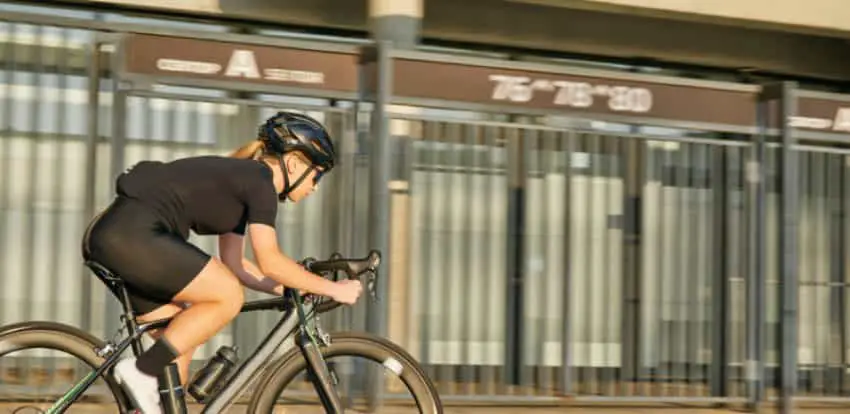You’ve probably noticed that the handlebars on a road or mountain bike are much lower than on a more casual bike, like a beach cruiser. Is there a reason for this, or is it simply all about style?
Let’s break down how handlebar height affects your riding.
Why Bike Handlebars Are So Low
Many bike handlebars are set low so the rider can maintain a more neutral riding position, with their weight distributed evenly over the front and rear wheels. Lower bars ensure the front wheel is weighted enough to optimize steering and braking performance, but not so much as to risk an over the bars (OTB) incident!
Weight distribution is crucial to the effective and safe operation of a bike, and that depends heavily on your body position while riding. As the handlebars are one of the main contact points between you and your bike, handlebar height will have a significant impact on your body position.
Why Road Bike Handlebars Are Low

Road bike handlebars are mounted very low relative to the bike’s frame (often not much higher than the bike’s top tube). Many even feature drop bars: handlebars with an alternate curved grip that allows the rider to take an even lower hand position.
What’s the point of these drop bars, aside from helping maintain a more neutral riding position?
Drop bars allow you to shift even more weight over the front wheel. This is useful in certain cases, like when climbing.
If you’ve ever climbed a hill in a very upright position, you’ve probably noticed the front wheel likes to unweight itself from the ground. This makes steering much more difficult. Low bars allow you to lean over the front of the bike and keep your tire planted.
Road bike riders value lower handlebars for the more aggressive, aerodynamic riding position it places them in. This is an important factor especially during races, where speed is the difference between winning and losing. A rider is able to achieve a faster speed and minimize the effects of wind resistance when in a crouched, aggressive riding position.
Why Mountain Bike Handlebars Are Low

Mountain bike handlebars typically aren’t as low as road bike handlebars: when riding rough terrain, especially downhill, low handlebars can shift too much weight over the front wheel…not an ideal situation if you want to stay in the saddle and avoid going OTB!
Not all mountain bike handlebars are flat like road bike handlebars: some bend upward from the center. The vertical distance from the handlebar’s center to the bar end is called rise, and this can range from 5mm to over 40mm. However, there are many styles of mountain bikes for very different riding disciplines, and some do benefit from having lower handlebars.
Mountain bikers may want lower handlebars if they do a lot of technical climbing. When climbs are full of rocks and roots, keeping traction on the front wheel is essential. A rider who prioritizes speed and efficiency on the climbs and doesn’t do a lot of fast, rowdy descending may also choose lower-rise bars for a more aggressive, aerodynamic riding position.
Are Higher Handlebars More Comfortable?
If you’re like me, every time you pass by road cyclists you think to yourself, “that hunched over riding position just does NOT look comfortable!”
It’s true that riding in a hunched over position for long periods of time can get uncomfortable. It can also have an impact on your posture and back health. This is another reason road bikes have drop bars: multiple grip options means you can switch up your riding position once in a while to alleviate the stress placed on your back and neck!

Higher handlebars certainly can be more comfortable for longer distance riding. They can also help you maintain a more neutral spine position, putting the vertebrae in your upper back and neck into a more natural alignment.
This is something I sought out myself: my mountain bike came stock with very low-rise bars, and I experienced neck and upper back discomfort any time I rode more than a couple hours. Switching to a 30mm rise bar allowed me to lift my chest, pull my shoulders back, and pick my head up…all of which instantly alleviated my back and neck pain.
Additionally, as someone who gives more consideration to descending over climbing performance, switching to a high-rise bar was a no-brainer!
When You Should Adjust Your Handlebars
Everything on your bike is customizable. Just because it came that way, doesn’t mean that’s the optimal way it should be for your unique riding style and anatomy. There are quite a few cases in which you may want to play around with the height of your handlebars.
You Experience Pain or Discomfort While Riding
Let’s start with the most significant reason: physical pain or discomfort. If you’re experiencing any back or neck pain while cycling, your riding position is the likely culprit. Adjusting your handlebar height is a great place to start addressing this issue, and in many cases that’s all you’ll need to do.
If raising your handlebars or choosing a higher-rise bar doesn’t fix the problem, you could also try a different length stem, a different saddle shape, size or angle, or even a different frame size (a frame much too large or too small for your height will put you in a less than optimal body position and could cause long-term pain).
Your Front Wheel Lifts on Climbs
You can only steer your bike if your front wheel is on the ground. To keep the front wheel planted, especially on climbs, you need to keep enough body weight over it. Bars that are too high can make this difficult.
Lower bars allow you to more easily shift your weight over the front wheel to improve grip. This also improves cornering performance, since your front wheel can dig into the terrain better. If you do a lot of climbing, it may be worth lowering your bars a bit or choosing a lower-rise option.
You Prioritize Descending Performance
When I ride, I’m not too concerned with how long it takes me to climb to the top of the trail. I’m way more interested in getting the best performance out of my bike on the way down, especially when those descents are steep and technical.
If you also like shredding fast descents and want your bike to be stable and controllable downhill, you’re going to want higher-rise bars. High-rise bars help you shift your body weight back, which is particularly important on descents.
When you’re pointed downhill, any little bump can shift your weight forward, which could send you OTB. With high-rise bars, it’s much easier to keep your weight centered over the bike and to shift it over the rear wheel when the trail gets really steep. This keeps both wheels in contact with the ground, which means more traction…which means more control!
Check out the video below for more on what bar height you should be running based on the type of riding you do:
Should Bike Handlebars Be Higher Than the Seat?
Generally, bike handlebars will be a bit higher than, or level with, the seat. The difference in height between handlebar and seat will come down to the type of bike you have and the style of riding you do.
Road, XC and some trail bikers will typically choose handlebars that are level with or a few inches above seat height. This puts the rider in an aggressive, forward leaning position, which is more aerodynamic.
Other trail bikers, along with enduro and downhill riders, will prefer seats much lower than their handlebars. A more upright riding position improves control, handling and weight balance on rough descents.
Regardless of the type of riding you do, you definitely don’t want a seat that is higher than your handlebars. This would shift your weight forward way too much, which could put you at risk of going OTB on flats or descents.
However, all of the above guidelines are irrelevant if you have a bike with a dropper post. A dropper post allows you to always be in the best riding position no matter the terrain: raise the seat to be more aggressive on the climbs, and lower the seat to get it out of the way on steep descents.
But make sure that when you install your dropper post, the seat remains level with or slightly lower than your handlebars when the seat is at full extension.
How to Adjust Your Bike’s Handlebars
The goal of adjusting your handlebar height is to get you into the best body position for the type of riding you do…and there are three main methods for achieving this:
- Remove or add spacers under your bars
- Choose a bar with more or less rise
- Choose a shorter or longer stem
This video explains the difference between these three methods:
While changing handlebar rise and stem length obviously require purchasing new components, adjusting bar height is free: you just need to reposition the spacers on your bike’s head tube.
You can see how to do that here (works for road or mountain bikes):
One last thing to note: only try one of these three methods at a time!
If you make changes to all three at once, you could end up either canceling out the adjustments (ex. Choosing a lower-rise bar will shift your weight forward, and adding spacers under the bar would shift it back!) or making such a drastic change to your body position as to render your bike uncontrollable and awkward to ride.
Small adjustments make a big difference: change one thing at a time so you can constantly test and see what works best for you.
